
Lotus
Cars
John's
Online
LOTUS
Museum
Lotus
Automobiles
|

|
John
Mammarella
|
.

.

Colin
Chapman
Anthony
'Colin'
Bruce
Chapman
.
Born: May 19,
1928------------------------
Died: December
16, 1982 (aged 54)
Colin
Chapman
.

.
|
.
On May 19,
1928, the founder of Lotus, Anthony Colin Bruce Chapman, was born in Richmond,
Surrey, to Stanley Frank Kennedy Chapman and his wife Mary, who ran The
Orange Tree Pub there.
Colin was only
two years old when the family moved to Hornsey in North London, where Stanley
took over the the running of the Railway Hotel, off Totenham Lane, right
beside the main line north to Scotland from the King's Cross railway station.
Just before the
end of World War 2, Stan Chapman moved the family again, to a house in
Beech Drive, North Finchley, while continuing to run the Hornsey pub.
.
Colin's youth
was filled with typical English boyhood antics and schooling.
Stan Chapman
had great ambitions for his son, and to some extent adopted the airs and
graces of upper middle-class life.
When it suited
him, he would hypenate the family name to Kennedy- Chapman.
He was sure that
Colin would go far when in 1945, at the age of 17, he won a place at the
University College of London University to study engineering .
.
Colin
used a Panther 350cc motorcycle to travel around on.
Colin rode to
college from Finchley on the Panther.
Unfortunately
the Panther was short lived, as by the University's welcoming dance that
November, the motorcycle was written off when he hit a taxi and destroyed
the bike.
His interest
in motorcars had yet to be developed, but that changed with the arrival
of Christmas, when Colin was presented with a 1937 Morris 8 Tourer, which
was maroon in color.
His parents felt
that he would be safer on four wheels, rather than two.
.
The Morris
was lavished with Chapman's attention and was used for transporting himself
to and from his home and the University.
Often he would
have fellow students Colin Dare and Hazel Patricia Williams, (who Chapman
had met at a dance in 1945), as passengers
in his journeys.
These journeys
were not without adventure and peril.
Chapman turned
them into sport, always interested in setting new records for traveling
the distance between home and Hazel's, and Colin Dare's and school in the
shortest amount of time.
.
It was soon
after entering the London University, that Chapman and Colin Dare began
a used car sales business.
The year was
1946 and cars were scarce.
The business
boomed, growing to one or two cars being bought and sold per week.
Often classes
were skipped in order that "deals" could be secured.
As the inventory
of cars grew, the space to keep the cars became insufficient, and the two
Colins were seen stashing cars in the shed behind Hazel's home.
The normal buying
and selling became easy and the two Colins started modifying and improving
their cars before placing them up for sale.
This brought
greater profits, but more work.
This booming
business was not to last, because in 1947 the British government did away
with the basic gas rationing, and new cars became plentiful and the demand
for used vehicles crashed.
The business
was disbanded, and all that remained was an old trashed 1930 Austin 7.
It was registered
as PK 3493.
.
This old Austin
was to be the basis of the first Lotus, the Mark 1.
The Austin was
modified into a trials car, (a very English auto competition of driving
cars through all sorts of terrain against time). Many of the construction
techniques were those that Chapman had learned while studying aircraft
construction at school.
Only the chassis
and drive train were retained as Chapman fashioned a totally new body,
and modified the engine and suspension.
It was re-registered
as OX 9292.
Two trials were
entered in the spring of 1948 and the Mark 1 Lotus scored its first two
class wins.
Chapman continued
to develop and modify the Mark 1.
First larger
wheels and tires were fitted and the front beam axle was split and hinged
in the centered to provide independent front suspension.
However, with
the coming of late spring, work on the Mark 1 tapered
off to benefit
Chapman's studies.
By the end of
1947, Colin Chapman had completed his engineering studies and officially
attained a Bachelors of Science in Engineering degree.
.
By now Chapman
was quite familiar with the short comings of the Mark 1, and the construction
of a Mark 2 appealed to him in order to eliminate those inadequacies.
Work had only
begun on the new car when Chapman enrolled in military service in the RAF,
where he learned to fly.
He became even
more intrigued by airplanes, specifically, in their flight and engineering.
It was to be
an important experience for this budding engineer.
During
his leaves Chapman would return to the garage behind Hazel's home to work
on the Mark 2.
At times Hazel
began to resent the attention the new car was getting. Chapman had little
time for dates, and instead, before rushing back to camp, he would present
her with a job list that had to be completed before Chapman's next leave.
.
The Mark 2
was completed by late 1948, and was registered as LJH 702.
The speed and
performance of the Mark 2 further enthused Chapman's interest in motor
sport, however that was not until a 1172cc Ford 10 engine had replaced
the worn Ford 8 engine in 1949.
.
In September
of 1949 Chapman's stint with the RAF was completed, and since a future
in the RAF had no appeal to him, he returned to civilian life.
By December,
Chapman was employed by a company of constructional engineers in London.
A life of bridge
building seemed to lie ahead for Chapman, something he secretly did not
want.
By Christmas
the Mark 2 had grown a shapely radiator cowl and an ingenious system for
the headlamps.
They were mounted
in the cowl and were made to turn with the steering.
The spring of
1950 proved how competitive the Mark 2 was with class wins in trial after
trial.
The Mark 2 was
sold to Mike Lawson, (the uncle of Sterling Moss), and Mike continued to
win during the next year.
In the fall a
new formula was introduced for closed circuit racing, 750cc Formula racing.
Thus, by January
of 1951, work on the Lotus Mark 3, (a car designed to meet the requirements
of this new formula), had begun.
It was this third
Lotus that really caught the eyes of the racing community.
The registration
was LMU 4.
.
With Chapman
in the driver's seat, the Lotus Mark 3 consistently won races.
It was clearly
the fastest of the 750cc Formula.
The Mark 3 showed
all of the now classic signs of the future Lotus.
It was light,
lean, and innovative.
It did not merely
win, it ran circles around the competition.
It forced the
authorities that governed racing to regulate specifically against
the Mark 3 in order to preserve equality.
This was, (as
was to be seen in the future), only the first of such occasions where rules
were written with Lotus specifically in mind. The die was cast, and the
racing community had been put on it's ear.
By November of
1951 Mike Lawson returned to Chapman ready to purchase a faster Lotus.
By the end of
1951 it was apparent that other competitors were interested, and inquiries
began to flow into Lotus about obtaining copies of this winning car.
Copies of the
Mark 3 were built and the Mark 4 was put into motion. The First of January
of 1952 marked the official beginning of the Lotus Engineering Company,
which was now located in Chapman's father's building in Hornsey.
.
The Mark 4
was completed and was sold to Mike Lawson who scored class wins in
race after race in 1952.
By late 1952
Chapman had noted the demand that existed for the sale of components that
assembled into a complete car.
The Mark 5 was
shelved to design and build components for this market.
It was do to
this that the Mark 6 was born.
Chapman had noted
that the twin channel chassis construction of the Austins became heavy
when properly reinforced, thus with his engineering knowledge Chapman designed
a robust multi-tubular space-frame.
The new structure
was light, yet extremely rigid.
There was no
room for excess, every tube had a job.
The resultant
space-frame for the Mark 6 weighed only 55 pounds,
and when panels
and mounting brackets were added, the full weight tipped only 90 pounds!
The success of
the Mark 6 was verified by the list of customers lined up to purchase copies
of the winning car.
.
The Mark Seven
was developed in an effort to streamline production of the Mark 6.
In true Lotus
fashion, improvements were made on the original design.
.
By late 1953
the Mark 8 was introduced, and Chapman finally married Hazel Williams in
October of 1954.
The small firm's
cars continued to flourish, their cars finishing with numerous victories,
generating orders for the Chapman creations to pour in at rates far exceeding
production capability.
Finally, since
the 26 year old Chapman was no longer able to hold down two jobs, (the
one with British Aluminum AND the running of a full time car construction
firm), the budding Lotus company was triumphant - Chapman became theirs
full time as of New Year's Day of 1955.
.
The next few
years were spent pursuing victories at Le Mans, with the Mark 9, the Lotus
Eleven, and the Lotus Type 14 Elite.
By 1960 the Le
Mans victories were in hand and Chapman's interests in racing turned from
Sports Racing vehicles to open wheeled race
cars, meaning
Formula Junior, Formula One, (the World Series of racing, an arena dominated
by the likes of Ferrari, Mercedes, Porsche, Cooper and BRM), and Indianapolis
Cars.
.
From 1960
to 1981, Chapman and Lotus became the winningest Formula One Team, posting
championship after championship. Establishing a tradition of winning by
a total commitment to creating a superior performing car through superior
engineering and innovation.
.
It was the
dedication to superior engineering and innovation that took Chapman and
Lotus to an Indianapolis victory in 1965, and led to fielding the infamous
STP Turbine cars and 4- wheel drive cars of the late 60's.
It was this same
dedication that created the first full composite chassis for a road car,
(the Type 14 Elite), the first successful full monocoque racing chassis,
(the Type 25 F1 car), and the first successful fully stressed engine for
racing, (the Ford DFV V8).
.
It was the
Chapman's connections that brought Ford's money to the small firm of Cosworth,
operated by two old employees, Frank Costin and Keith Duckworth.
From this came
the winningest Formula One engine in history, the Cosworth Ford DFV.
The first win
came with Jim Clark at the 1967 Dutch Grand Prix.
It was the maiden
race for the sleek, ultra-light Lotus 49 powered by the Cosworth Ford in
its first race.
The competition
was overwhelmed by the superior chassis and engine, and the victory was
Clark's.
.
In 1970 Chapman
revealed a dramatically different sort of F1 car.
It was the Type
72.
This car removed
the single large radiator which was used for engine cooling from the front
of the car, and replaced it with two smaller radiators which were mounted
in pods situated on each side of the driver.
The front
disc brakes were moved into the body of the car, (where the radiator used
to be), in order to get them out of the air stream, and to reduce un- sprung
weight.
Ingeniously,
the tops of the rotors were left exposed, enclosed in 'chimneys' to vent
air that was brought in via flush NACA ducts in the nose cowl to aid in
cooling the brakes.
The brakes were
connected to the front wheels by short brake- shafts.
The rear brakes
were also mounted in-board, to cut down on un-sprung weight, and to also
reduce turbulence in the air stream.
This allowed
Lotus to effectively give light weight 'qualifying' type tires race-distance
life.
The car also
did away with the conventional type of suspension, and used a rising rate
torsion-bar suspension instead, ( on both front and rear), and in-board
mounted dampers, which also removed these components from the air-stream.
All of
this allowed for minimal frontal area, and the cars nose became a sharp
wedge.
The car was jokingly
referred to as a 'door- stop', but nobody laughed when the car started
winning, and Lotus again forced the other teams to play catch-up.
.
In 1978 Chapman
unveiled the Lotus 78 Formula One race car and once again the rule books
would have to be rewritten, as would automotive history.
The Lotus 78
used bodywork on the underside that effectively created a venturi, thus
as the air rushed under the car the air was forced to accelerate and the
pressure of the air was lowered dramatically.
The result was
downforce that was never before imaginable, (in excess of 2000 pounds of
downforce was created in addition to Lotus 78's 1250 pound weight).
The Lotus 78
was said to corner as if truly on rails, and won six Grand Prix's in 1978.
The impact upon
racing created by ground effects cars were so astounding that by the end
of 1981 the ground effects Formula One cars were banned.
They were replaced
with flat bottomed cars in 1982.
.
When Chapman
died on December 16 of 1982, (from a massive heart attack), no one questioned
the incredible influence that Chapman, (and his small English motor car
company), had upon the engineering and manufacture of automobiles both
for racing and for the street.
Every single
automobile on the race track, (and on the road today), owes some part of
its design and engineering to Anthony Colin Bruce Chapman, and his Lotus
company.
.
We as racing
enthusiasts miss the sight of Colin Chapman's black cap sailing across
the track as one of his Formula One race cars streaks across the finish
line, as Lotus wins another one of the Grand Prix races.
We as automobile
enthusiasts miss the feeling of great anticipation of what the brilliant
mind of Colin Chapman would bring to the roadways for us to enjoy.
And, yet the
Lotus Legend lives on, within the Lotus factory in Hethel, England, and
with the current Lotus race cars.
It is truely
unfortunate that Colin Chapman is not here to lead them back to their former
heights of glory.
.
It has been
said that Colin Chapman accomplished more to influence the modern automobile
than any other human.
It is enough
to say that automotive engineering and automobiles are in their present
state of development due to Colin Chapman, who was a true genius and engineer,
a driver & an enthusiast, and an innovator.
He gave us monocoque
contruction (unit body), aerodynamics, ground effects, the first 4 valve
per cylinder heads on a mass produced engine, ABS brakes, active suspension,
and the use of composite materials to save both weight and add strength,
to name just a few of the things that we have him to thank for.
That is quite
a statement considering the greats who are Chapman's peers.
.
The racing record
of Lotus is unsurpassed, and it is a tribute to the engineering brilliance
of Colin Chapman and the organization that he has left behind.
.
|
.
Some
Famous Chapman Quotes:
.
* "Simplicate, then add lightness."
.
* "You won't catch me driving a race car that I have built." (This
remark was obviously tongue-in-cheek, as numerous photos exist
of
Chapman driving racing cars that he built.)
.
* "Make the suspension adjustable and they will adjust
it wrong -- look
what they can do to a Weber carburetor in just a few moments of stupidity
with a screwdriver."
.
* "To add speed, add lightness."
.
* "Any car which holds together for more than a race is
too heavy."
(Also
tongue-in-cheek, as race cars must test and qualify before the
start
of any race.)
.
* "Accountants are the scorers of industry; they have nothing to do with
playing the game."
(Probably
not so tongue-in-cheek, as Chapman was implicated in the
DeLorean
scandal shortly before his death.)
.
|
.

.
|
.
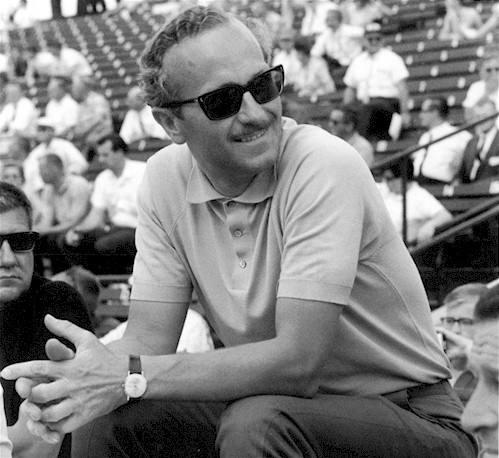
.
|
.
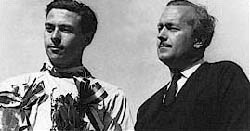
.
|
.

.
|
.

.
|
.

.
|
.
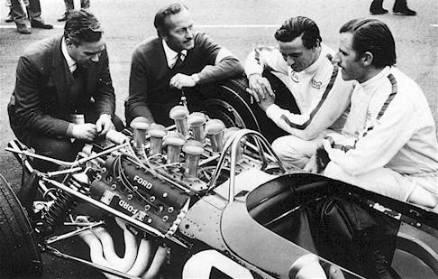
.
|
.
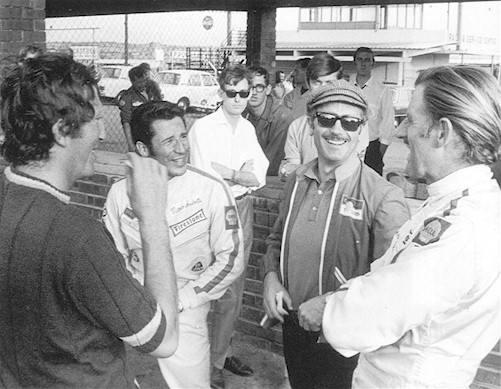
.
|
.
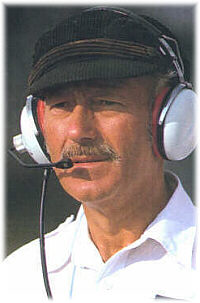
.
|
.
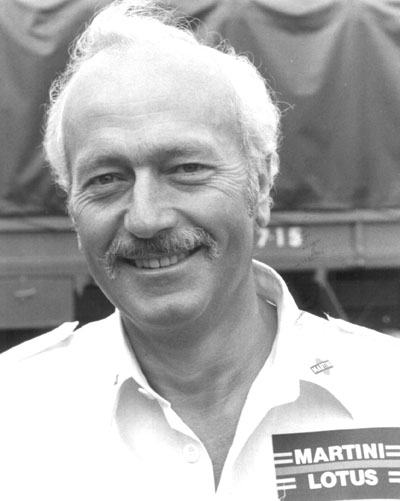
.
|
.
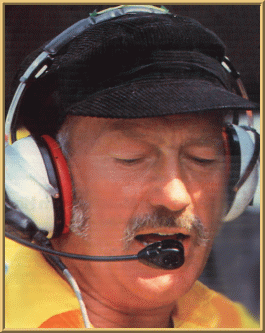
.
|
.

.
I had the
good fortune to meet both Colin Chapman and Jim Clark in 1966.
.
For the family
vacation that year, my parents decided that we would visit some relatives
who lived in Chicago.
(These relatives
had stayed with us in 1965, so that they could go to the Worlds Fair which
was being held in New York.
It was at that
time that my uncle bought me my first slot car, a K&B Cobra Daytona
coupe, at the Lee's Hobbies Raceway, on the East Meadow / Levittown border.)
I was fourteen
years old, and was an avid slot-racer, so I brought my race kit along with
me.
.
During the
trip out from New York, we had experienced really bad traffic problems,
so my father decided that we would make the return trip by going up to
Canada, and taking the Trans-Canadian Highway back to New York.
The Trans-Canadian
Highway was very beautiful, but also a bit scary because you could go for
long distances without seeing another vehicle.
You would be
out of luck if you broke down.
We entered
back into New York in the Finger Lakes Region, which is where Watkins Glen
is located, and got a motel room for the night.
This area is
also the home of Corning Glass, and the next morning, while my mother and
younger brother and sister took the Corning Factory Tour, my father and
I set out in search of the race track, which was about 30 miles away.
.
As luck would
have it, the U.S. Grand Prix had just been run there, and there were still
plenty of cars to be seen on their transporters.
After
a pleasant morning of looking around, my father and I stopped at a small
bar & grill to get some lunch.
Imagine my surprise
when we ran into both Colin Chapman and Jim Clark of the Lotus team, who
had just finished eating and were standing at the bar.
My father, being
a very personable man, introduced us and bought a round of drinks.
When asked
about my interests, (to engage me in conversation, as I was in awe and
a bit tongue-tied), both of the Lotus men seemed genuinely interested
in my explaination of slot-racing, and I went out to the car to get my
race box.
I showed Colin
and Jim my 1/24th scale Formula One car, which had
a Lotus Type 25 body on it.
I had scratch-built
this car, hand-soldering the chassis for it from brass tubing and piano
wire for strength and to save weight, and I even rewound the armature of
the electric motor and replaced the magnets in it to get more revs and
greater speed.
(Looking back,
the car was a miniature technical marvel, and I had learned quite a bit
of science to build it.)
I was very proud
of this car because I had won a number of races with it at EMMRA,
where I raced.
Before
we all left to go our seperate ways, Colin Chapman went out to the trunk
of his rental car and removed a soiled Lotus mechanics shirt from it.
To say that my
fourteen year old self was in racing heaven when he gave it to me would
be an understatement.!
I have
been a die-hard Lotus fan from that day on.
.
JMM.----------
(Copywrite
©
Taracomm 2005-2006)
(All
Rights Reserved)
.

.
More information
about Slot Racing can be found here.
.
|
..
Music:
"Theme From Miami Vice"
by
Jan Hammer
.

.

.
|
|